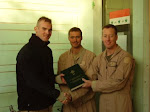Here is the second part of the post from last Thursday on "The Hermeneutic of Continuuty Defined" and quotes our Holy Father Benedict in an address to bishops in 2005.
"On the one hand, there is an interpretation that I would call "a hermeneutic of discontinuity and rupture"; it has frequently availed itself of the sympathies of the mass media, and also one trend of modern theology. On the other, there is the "hermeneutic of reform", of renewal in the continuity of the one subject-Church which the Lord has given to us. She is a subject which increases in time and develops, yet always remaining the same, the one subject of the journeying People of God.
"The hermeneutic of discontinuity risks ending in a split between the pre-conciliar Church and the post-conciliar Church. It asserts that the texts of the Council as such do not yet express the true spirit of the Council. It claims that they are the result of compromises in which, to reach unanimity, it was found necessary to keep and reconfirm many old things that are now pointless. However, the true spirit of the Council is not to be found in these compromises but instead in the impulses toward the new that are contained in the texts.
"These innovations alone were supposed to represent the true spirit of the Council, and starting from and in conformity with them, it would be possible to move ahead. Precisely because the texts would only imperfectly reflect the true spirit of the Council and its newness, it would be necessary to go courageously beyond the texts and make room for the newness in which the Council's deepest intention would be expressed, even if it were still vague. In a word: it would be necessary not to follow the texts of the Council but its spirit. In this way, obviously, a vast margin was left open for the question on how this spirit should subsequently be defined and room was consequently made for every whim.
"The nature of a Council as such is therefore basically misunderstood. In this way, it is considered as a sort of constituent that eliminates an old constitution and creates a new one. However, the Constituent Assembly needs a mandator and then confirmation by the mandator, in other words, the people the constitution must serve. The Fathers had no such mandate and no one had ever given them one; nor could anyone have given them one because the essential constitution of the Church comes from the Lord and was given to us so that we might attain eternal life and, starting from this perspective, be able to illuminate life in time and time itself.
Through the Sacrament they have received, Bishops are stewards of the Lord's gift. They are "stewards of the mysteries of God" (I Cor 4: 1); as such, they must be found to be "faithful" and "wise" (cf. Lk 12: 41-48). This requires them to administer the Lord's gift in the right way, so that it is not left concealed in some hiding place but bears fruit, and the Lord may end by saying to the administrator: "Since you were dependable in a small matter I will put you in charge of larger affairs" (cf. Mt 25: 14-30; Lk 19: 11-27).
"These Gospel parables express the dynamic of fidelity required in the Lord's service; and through them it becomes clear that, as in a Council, the dynamic and fidelity must converge.
The hermeneutic of discontinuity is countered by the hermeneutic of reform, as it was presented first by Pope John XXIII in his Speech inaugurating the Council on 11 October 1962 and later by Pope Paul VI in his Discourse for the Council's conclusion on 7 December 1965.
"Here I shall cite only John XXIII's well-known words, which unequivocally express this hermeneutic when he says that the Council wishes "to transmit the doctrine, pure and integral, without any attenuation or distortion". And he continues: "Our duty is not only to guard this precious treasure, as if we were concerned only with antiquity, but to dedicate ourselves with an earnest will and without fear to that work which our era demands of us...". It is necessary that "adherence to all the teaching of the Church in its entirety and preciseness..." be presented in "faithful and perfect conformity to the authentic doctrine, which, however, should be studied and expounded through the methods of research and through the literary forms of modern thought. The substance of the ancient doctrine of the deposit of faith is one thing, and the way in which it is presented is another...", retaining the same meaning and message (The Documents of Vatican II, Walter M. Abbott, S.J., p. 715)."
With thanks to The Hermeneutic of Continuity.
Biblical Basics about Mother Mary – A Homily for the Second Sunday of the
Year
-
In this Sunday’s Gospel passage of the wedding feast at Cana, there is a
theological portrait of both Mother Mary and prayer. Let’s look at the
Gospel al...
4 days ago











No comments:
Post a Comment